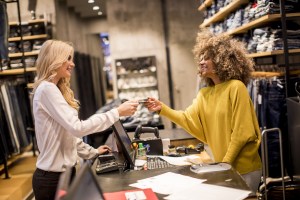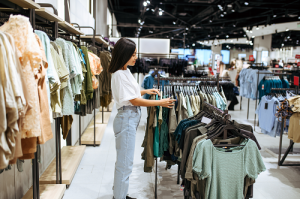The consumer journey for fashion is out there on its own



Our contention is the fashion retail lifecycle is uniquely different from other sectors. Discover the secrets behind the consumer journey.
Salesforce Authors
Our contention is that the fashion retail lifecycle is uniquely different from other sectors…
Firstly, let’s divide this up. There are two main behaviours in apparel-buying activities – functional (“I can’t leave the house unless I have pants on”) and fashionable (“I want to look fabulous, whatever ‘fabulous’ means this week”). They aren’t entirely distinct from each other; there is an overlap in behaviour and drivers. But just for the sake of demonstration, let’s assume they are for now.
1. Functional apparel consumer journey:
Functional clothes buying follows a traditional kind of needs-driven journey. The customer lifecycle follows a reasonably standard pathway. Something like:
Awareness -> (Perhaps onto a database and some onboarding) -> Engagement -> Consideration -> Purchase -> Loyalty -> Advocacy.
i.e. I need some everyday underwear. I am aware of several brands that fit the bill. I get some email from one of them -> That brand tops my consideration list -> Instore, that brand is in my price range -> I buy and I am more likely to buy again if I am happy with the product ->“Oh you need underwear? Try brand X, they’re cheap and effective.”
Functional buying is a mostly rational process. The emotional brand element does of course come into play when choosing brand X over brand Y, but the needs-driven functional element is dominant in driving the customer down the pathway to purchase, along with what we consider to be the traditional consumer journey.
2. Fashion apparel consumer journey:
Fashion journeys are very different.
Fashion is a very non-rational purchase. It’s almost wholly emotional – one’s fashion is an extension or display of deep-seated identity. There is rarely a rational reason that one would pay X amount over the odds for a piece of clothing. Consideration is entirely influenced by “what is fashionable” which is a subjective measure, created by people/media/influencers with whom the consumer often has no real relationship. Magazines, celeb endorsements, even someone randomly walking down the street looking great in a pair of shoes that suddenly become an “object desire.”
The fashion “journey” is chaotic. Consider our usual journey from functional, above:
Awareness -> Onboarding -> Engagement -> Consideration -> Purchase -> Loyalty -> Advocacy
A fashion-driven consumer can join the journey at any point and leap straight to any other point of the journey
Consider: I have never heard of Jimmy Choo shoes (hey! It’s hypothetical!).
I walk down the street and see someone wearing some amazing shoes. I am smitten. I run up to them – “Excuse me I just have to know where you got those…” – they tell me and I am straight round the corner to the shop that sells them.
And when I (inevitably) take a photo and Instagram it about 4 nanoseconds after receiving the receipt, I become an advocate. People may share that photo hundreds of times. My friends may leap out of their chairs and head for a shoe shop.
And I may not even like them after wearing them for a week. I may hate them and decide to give them to a charity shop.
So:
- I can jump straight from nowhere to awareness to purchase in minutes
- I can become an advocate moments later (with considerable influence) without ever being actually loyal
- I had no functional/rational need for shoes at that moment. I wasn’t thinking of buying anything.
Now consider this:
One of my friends is a fashion student. She has no money to speak of and only wears charity shop buys. She is on the money when it comes to fashion and has a blog, which is reasonably well-read.
She sees the picture and retweets it to her followers. It is seen, eventually, by thousands of people, along with a blog post she writes, and the various Instagram and Pinterest posts generate thousands more views.
She has become a valuable advocate for Jimmy Choo, even though she cannot possibly afford to ever own even a single pair of their shoes. Maybe she now looks for the new product launches – she’s loyal! – and advocates for them too.
So:
- She jumps from awareness to loyalty and advocacy without ever passing through purchase (as she has no money)
Moving on:
Later, she sees Kate Moss, a celebrity model she loves, wearing a particular brand of jeans in a photo on someone’s Twitter feed. She has never seen that brand before and has no idea how they wear, feel, etc. But she loves Kate and if Kate is wearing them they must be fabulous.
She writes, tweets etc. Again, she has jumped straight to advocacy without even ever touching a pair of those jeans.
But since she wants to be on top of things, she finds their website, signs up for email, follows their Twitter feed and Likes their Facebook page. She may buy some eventually (on special offer from their Twitter feed, say). She engages with the brand with retweets and repins.
And she really likes the jeans, too.
Except for one day, Kate stops wearing them and sneers at a lesser celebrity wearing them for being “passé”
Within an hour, our fashionista friend has unfollowed all the social media accounts of that brand, at the very least untagged and possibly deleted her own blog posts about them, and may even have posted something negative about the brand herself.
- She expressed a preference in the first place straight from awareness without ever encountering the product physically
- She became an advocate within seconds of becoming aware
- She jumped straight from loyal advocate to detractor in a heartbeat
These situations are hardly atypical. Fashion is eternally changing and brands that are top dog one minute can become hugely unfashionable and toxic in weeks (remember when Burberry suddenly became associated with that awful word “chav”?).
If left unchecked, the sneer will be retweeted, mentioned, posted, commented on and conversed about at hyper-speed. It could be the end of a smaller, less resilient brand.
But a crisis can often be an opportunity. What if, in our hypothetical Kate Moss sneer scenario, the brand has a route back? If they see the comment quickly enough and come back with a witty takedown of poor Kate, that might overtake the original comment and become brand-enhancing.
How to make sense of it all?
With fashion, the consideration phase lasts forever.
And it feeds any point in the journey at any time. Impulse buys, buys that have taken months to save up for, buys influenced by friends, buys influenced by total strangers. All can happen in a heartbeat or over considerable time.

Wait… is this bad news for fashion brands? Absolutely not! Completely the opposite in fact:
- All this tells us is that fashion brands need – almost more than anyone else – to have a presence at every point of the journey. If they do, then they can take care of business:
- Their advocates/influencers can change every moment of the day – how are they monitoring / amplifying / generally capitalising on that?
- Their campaigns can cause spontaneous purchases – IF their assets reach the right person at the right time or in the right place.
- Loyalty is so flaky, they need to be sure they can do everything in their power to capture positivity and see of negativity – how are they engaging with their acquired consumers?
- And with loyalty shifting so rapidly, they need to have a truly omni-channel presence to understand what their customers (and customers-to-be) are doing, how they’re behaving and what their current & future desires are likely to be.
And how do they react to something when it happens outside of opening hours?
“Always on” may be a cliché but in fashion, it’s as prevalent as ever – not least in the form of content marketing. Fashionistas are consuming content 24/7 – and you need to be there, measuring what works and ensuring the next round of content is hyper-relevant.
It’s all about the infrastructure being end-to-end. Their market is as unpredictable and spontaneous in its idiosyncrasies as the stock market. Stock traders know every second counts, so they have infrastructure that can react in less than a second, quicker than they can themselves. They know what is going on at every point of the process, wherever in the world and whenever it is happening.
Fashion retailers need to be in the same place – consideration is eternal, and it doesn’t go to sleep when they close the shop for the night or the customer service team clocks off.
Their customers are busy being fashionable 24/7/365…
Get further insights from our Connected Shoppers report to learn what consumers had to say about their shopping preferences and retail customer service experiences.





















